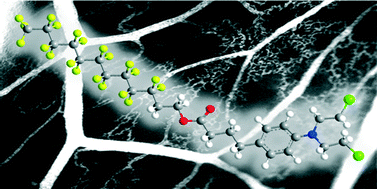Anti-angiogenic properties of chlorambucil derivatives with fluorous and hydrocarbon appendages†
Abstract
Chlorambucil (CLB) derivatives with long fluorous (referred to as 1 and 2) or hydrocarbon (3) chains have been evaluated in a series of in vitro and in vivo assays. In cell viability inhibition assays, both derivatives 2 and 3 show selective cytotoxicity towards human immortalized endothelial cells (ECRF24), while lacking activity against human ovarian carcinoma cell lines, contrary to the activity of CLB. Compound 3 also significantly inhibits sprout formation in an in vivo model of induced angiogenesis following photodynamic vascular occlusion in the chorioallantoic membrane (CAM) model. Moreover, intravenous administration of CLB and its derivatives in the non-perturbed CAM vasculature resulted in important changes in the vascular morphology. Notably, the growth of human ovarian carcinoma tumors implanted on the CAM was significantly inhibited by 2 and 3, i.e. by 70 and 53%, respectively, compared to vehicle treated tumors. Taken together, these results show that anchoring long fluorous or hydrocarbon chains to the carboxylic group of CLB leads to compounds showing increased anti-angiogenic activity which also effectively inhibit tumor growth in vivo.


 Please wait while we load your content...
Please wait while we load your content...